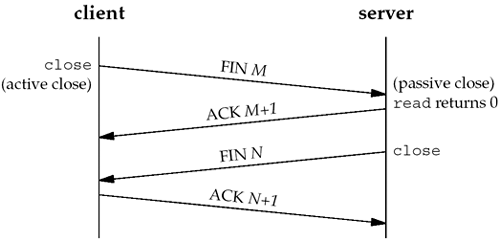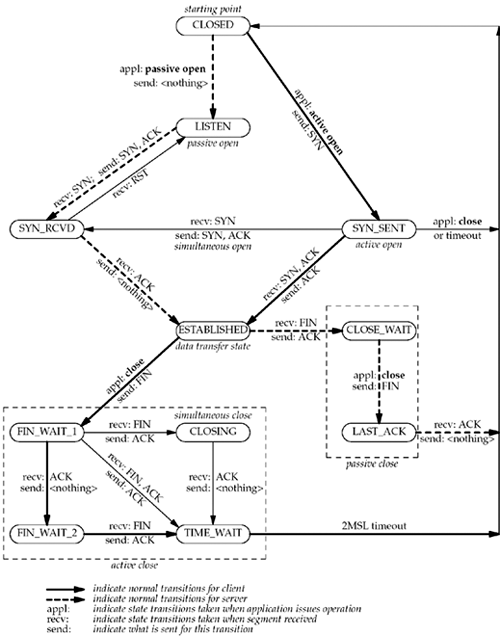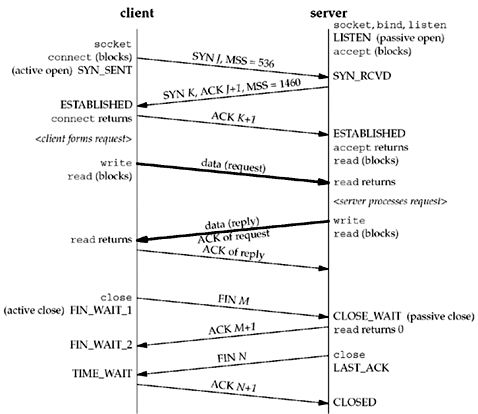2.6 TCP Connection Establishment and Termination
| To aid in our understanding of the connect , accept , and close functions and to help us debug TCP applications using the netstat program, we must understand how TCP connections are established and terminated , and TCP's state transition diagram. Three-Way HandshakeThe following scenario occurs when a TCP connection is established:
The minimum number of packets required for this exchange is three; hence, this is called TCP's three-way handshake . We show the three segments in Figure 2.2. Figure 2.2. TCP three-way handshake. We show the client's initial sequence number as J and the server's initial sequence number as K . The acknowledgment number in an ACK is the next expected sequence number for the end sending the ACK. Since a SYN occupies one byte of the sequence number space, the acknowledgment number in the ACK of each SYN is the initial sequence number plus one. Similarly, the ACK of each FIN is the sequence number of the FIN plus one.
TCP OptionsEach SYN can contain TCP options. Commonly used options include the following:
These common options are supported by most implementations. The latter two are sometimes called the "RFC 1323 options," as that RFC [Jacobson, Braden, and Borman 1992] specifies the options. They are also called the "long fat pipe options," since a network with either a high bandwidth or a long delay is called a long fat pipe . Chapter 24 of TCPv1 contains more details on these options. TCP Connection TerminationWhile it takes three segments to establish a connection, it takes four to terminate a connection.
Since a FIN and an ACK are required in each direction, four segments are normally required. We use the qualifier "normally" because in some scenarios, the FIN in Step 1 is sent with data. Also, the segments in Steps 2 and 3 are both from the end performing the passive close and could be combined into one segment. We show these packets in Figure 2.3. Figure 2.3. Packets exchanged when a TCP connection is closed. A FIN occupies one byte of sequence number space just like a SYN. Therefore, the ACK of each FIN is the sequence number of the FIN plus one. Between Steps 2 and 3 it is possible for data to flow from the end doing the passive close to the end doing the active close. This is called a half-close and we will talk about this in detail with the shutdown function in Section 6.6. The sending of each FIN occurs when a socket is closed. We indicated that the application calls close for this to happen, but realize that when a Unix process terminates, either voluntarily (calling exit or having the main function return) or involuntarily (receiving a signal that terminates the process), all open descriptors are closed, which will also cause a FIN to be sent on any TCP connection that is still open. Although we show the client in Figure 2.3 performing the active close, either endthe client or the servercan perform the active close. Often the client performs the active close, but with some protocols (notably HTTP/1.0), the server performs the active close. TCP State Transition DiagramThe operation of TCP with regard to connection establishment and connection termination can be specified with a state transition diagram . We show this in Figure 2.4. Figure 2.4. TCP state transition diagram. There are 11 different states defined for a connection and the rules of TCP dictate the transitions from one state to another, based on the current state and the segment received in that state. For example, if an application performs an active open in the CLOSED state, TCP sends a SYN and the new state is SYN_SENT. If TCP next receives a SYN with an ACK, it sends an ACK and the new state is ESTABLISHED. This final state is where most data transfer occurs. The two arrows leading from the ESTABLISHED state deal with the termination of a connection. If an application calls close before receiving a FIN (an active close), the transition is to the FIN_WAIT_1 state. But if an application receives a FIN while in the ESTABLISHED state (a passive close), the transition is to the CLOSE_WAIT state. We denote the normal client transitions with a darker solid line and the normal server transitions with a darker dashed line. We also note that there are two transitions that we have not talked about: a simultaneous open (when both ends send SYNs at about the same time and the SYNs cross in the network) and a simultaneous close (when both ends send FINs at the same time). Chapter 18 of TCPv1 contains examples and a discussion of both scenarios, which are possible but rare. One reason for showing the state transition diagram is to show the 11 TCP states with their names . These states are displayed by netstat , which is a useful tool when debugging client/server applications. We will use netstat to monitor state changes in Chapter 5. Watching the PacketsFigure 2.5 shows the actual packet exchange that takes place for a complete TCP connection: the connection establishment, data transfer, and connection termination. We also show the TCP states through which each endpoint passes . Figure 2.5. Packet exchange for TCP connection. The client in this example announces an MSS of 536 (indicating that it implements only the minimum reassembly buffer size) and the server announces an MSS of 1,460 (typical for IPv4 on an Ethernet). It is okay for the MSS to be different in each direction (see Exercise 2.5). Once a connection is established, the client forms a request and sends it to the server. We assume this request fits into a single TCP segment (i.e., less than 1,460 bytes given the server's announced MSS). The server processes the request and sends a reply, and we assume that the reply fits in a single segment (less than 536 in this example). We show both data segments as bolder arrows. Notice that the acknowledgment of the client's request is sent with the server's reply. This is called piggybacking and will normally happen when the time it takes the server to process the request and generate the reply is less than around 200 ms. If the server takes longer, say one second, we would see the acknowledgment followed later by the reply. (The dynamics of TCP data flow are covered in detail in Chapters 19 and 20 of TCPv1.) We then show the four segments that terminate the connection. Notice that the end that performs the active close (the client in this scenario) enters the TIME_WAIT state. We will discuss this in the next section. It is important to notice in Figure 2.5 that if the entire purpose of this connection was to send a one-segment request and receive a one-segment reply, there would be eight segments of overhead involved when using TCP. If UDP was used instead, only two packets would be exchanged: the request and the reply. But switching from TCP to UDP removes all the reliability that TCP provides to the application, pushing lots of these details from the transport layer (TCP) to the UDP application. Another important feature provided by TCP is congestion control, which must then be handled by the UDP application. Nevertheless, it is important to understand that many applications are built using UDP because the application exchanges small amounts of data and UDP avoids the overhead of TCP connection establishment and connection termination. |
EAN: 2147483647
Pages: 441
- Chapter III Two Models of Online Patronage: Why Do Consumers Shop on the Internet?
- Chapter V Consumer Complaint Behavior in the Online Environment
- Chapter VII Objective and Perceived Complexity and Their Impacts on Internet Communication
- Chapter X Converting Browsers to Buyers: Key Considerations in Designing Business-to-Consumer Web Sites
- Chapter XVI Turning Web Surfers into Loyal Customers: Cognitive Lock-In Through Interface Design and Web Site Usability



